The NSL years: 1977-2004
In 1977 four clubs, South Melbourne, Fitzroy United, Footscray JUST and Mooroolbark United, joined the inaugural National League competition, the Philips Soccer League. Opposition to the National League in Victoria was strong, with leading clubs fearing that it would undermine the State League and cost much more than it would bring in. Their reluctance was only overcome when Tom Bailey of Mooroolbark United announced that he would apply for membership. Mooroolbark finished rock bottom and lasted only one season in the National League, ultimately replaced by the newly created club, Newcastle KB United. Fitzroy United were the best of the Victorian clubs, finishing third behind inaugural champions Eastern Suburbs Hakoah.
South Melbourne finished in the same position in 1978, with Fitzroy United a couple of rungs down the table in fifth and Footscray JUST third from bottom. Fitzroy United relocated to Olympic Village in 1979, becoming Heidelberg United, and almost claimed the championship, finishing runners-up to Marconi. The lethal strike partnership of Gary Cole and Jamie Paton scored 21 goals between them, but they were no match for the combined tally of 31 from Mark Jankovics and young Victorian Eddie Krncevic. South Melbourne finished with the wooden spoon, but avoided relegation on a technicality. A much improved performance saw South finish third in 1980, just behind rivals Heidelberg United, who were runners-up again, this time to Sydney City by a solitary championship point. The Bergers were also bettered in the NSL Cup final, losing 3-0 to Marconi, but consolation came in the form of the Top 4 Finals Series, where the Bergers thrashed Sydney City 4-0 in the final at Bruce Stadium in Canberra, thanks to a hat-trick from Cole.
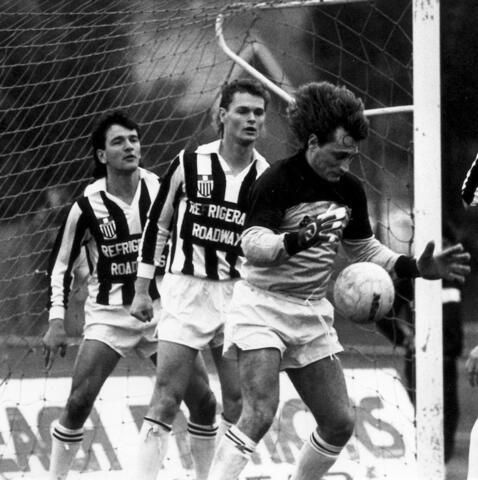
Preston Makedonia, as the Victorian State League Champion in 1980, were admitted to the league in 1981, finishing twelfth in a sixteen team league, ahead of Footscray JUST. It was South Melbourne's turn to occupy the runners-up position, losing out to Sydney City again who finished two games clear on the top of the table. The Bergers (4th) and an improved Preston (5th) finished just ahead of South Melbourne (6th), with Footscray JUST (14th) lucky to avoid the wooden spoon. 1983 witnessed marginal improvement, with Preston finishing third ahead of South Melbourne (4th) and Heidelberg United (6th).
In 1984 the National Soccer League (NSL) was increased from 16 to 24 clubs and divided into two conferences of twelve clubs apiece. The National Conference had eight clubs from Victoria, two from Queensland and two from South Australia. The Australian Conference comprised 10 clubs from New South Wales, one from the ACT and one from Northern New South Wales. First time entrants from the Victorian State League included Melbourne Croatia, Brunswick Juventus, Green Gully and Sunshine George Cross. Four Victorian clubs occupied the finals positions, with South Melbourne finishing on top and winning the National Conference finals. In the two-leg play-off for the national title, South Melbourne beat Sydney Olympic 2-1 in both legs. Charlie Egan nabbed both goals at Olympic Park and Oscar Crino and John Yzendoorn scored at Barton Park.

The following season, South Melbourne won the National Conference, but were eliminated in the finals by Preston Makedonia, who in turn fell short, conceding two late goals in losing to Brunswick Juventus 2-1 in the Conference final. Juventus won the Championship beating Sydney City 1-0 home and away, Fabio Incantalupo scoring both goals. In 1986, Brunswick Juventus topped the National Conference table, but it was Adelaide City which won the Finals series and would ultimately claim the championship with a two-legged 3-2 playoff aggregate win over Sydney Olympic.
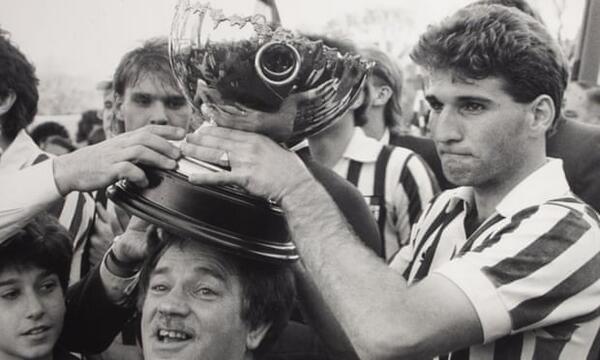
Come 1987, the NSL reverted to a single division with 14 clubs, with Brunswick Juventus, Footscray JUST, Heidelberg United, Melbourne Knights, Preston Makedonia, South Melbourne and Sunshine George Cross making up half the league. Despite the over-subscription of Victorian clubs, neither would challenge APIA Leichhardt for honours, with the Bergers finishing last and being relegated. 1988 would witness the introduction of the Finals Series to determine the NSL champion, South Melbourne finishing third with a host of NSW teams headed by Wollongong City. Marconi claimed the championship, winning four successive elimination finals to defeat Sydney Croatia on penalties. Brunswick Juventus were relegated, replaced by Heidelberg United for the 1989 season, the final winter season before the league would move to summer. Melbourne Croatia and Preston both finished in the finals, but neither would make the Grand Final, which was won by Marconi again. Heidelberg United would drop back down to the Victorian State League, along with the newly branded Melbourne City JUST. By the end of the following year, the club would ultimately be taken over by the Argentinian community, their history lost along with it.
As summer football began in 1989, the National Soccer League would bring to the fore two Victorian powerhouses, South Melbourne and Melbourne Knights, who had great success in the NSL throughout this period. South Melbourne were crowned champions in 1990–91 with the legendary Ferenc Puskás at the helm. The final, against Melbourne Knights, was played in front of 25,000 at Olympic Park and is remembered as one of the great finals of the NSL era. South were champions again in 1997–98 and 1998–99, where a young Ange Postecoglou would begin his coaching odyssey, while the Knights, led by Andrew Marth, Steve Horvat and a young but lethal Mark Viduka, won back-to-back titles in 1994–95 and 1995–96. South Melbourne (twice), Heidelberg United, Melbourne Knights and Collingwood Warriors won the NSL Cup.
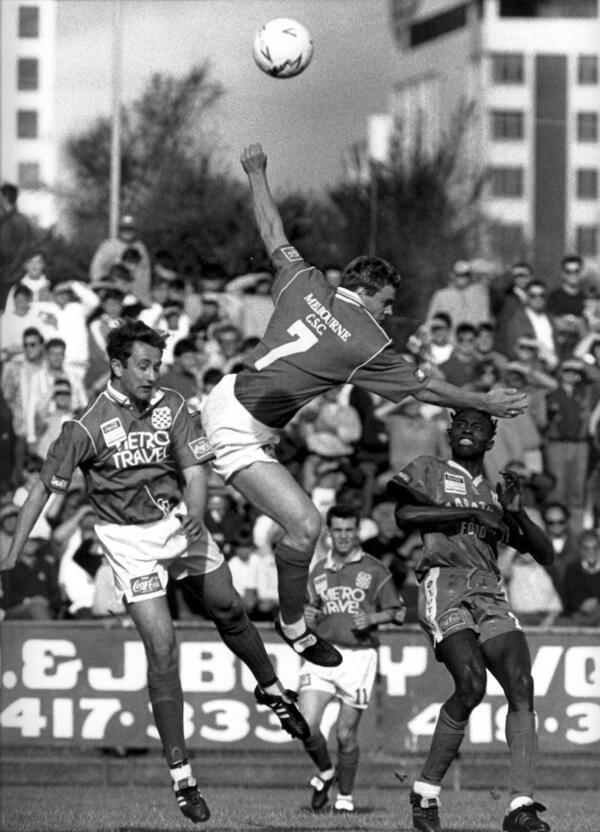
Collingwood Warriors, Carlton SC and Morwell Falcons (later Gippsland Falcons and then Eastern Pride) each participated in the NSL with varying degrees of success. The Warriors, had more than 10,000 fans to their first home match at Victoria Park, but the marriage between soccer and AFL didn't last beyond one season. Carlton tasted more success, reaching the Grand Final in its debut season, losing narrowly to a Con Boutsianis winner in a thrilling final against South Melbourne at a packed Olympic Park. The club invested heavily in youth, with Mark Bresciano, Vince Grella, Simon Colosimo, Archie Thompson and Josh Kennedy all coming through the Carlton ranks. Financial problems amidst a broken football landscape saw the club withdrew midway through its fourth season.
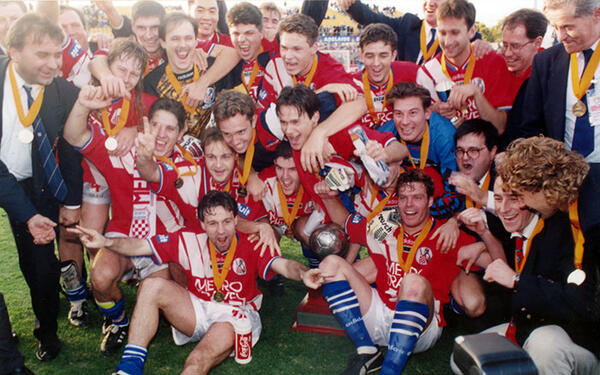
Morwell Falcons were the only regional Victorian club that competed in the NSL, and drew upon a greater history before it was finally admitted to the NSL in 1993. Founded by Italian migrants to the Latrobe Valley, the club had benefited from a VSF restructure in 1982, debuting in the Victorian State League that season, and winning it in 1984 and 1989. After steady improvement in its first couple of seasons in the NSL, the Falcons reached the finals in 1994-95 under Bobby McLachlan, but were eliminated 6-1 on aggregate by South Melbourne. The challenge of maintaining a place among the sport's elite would ultimately be too much for the regional club, and it too folded by 2001.
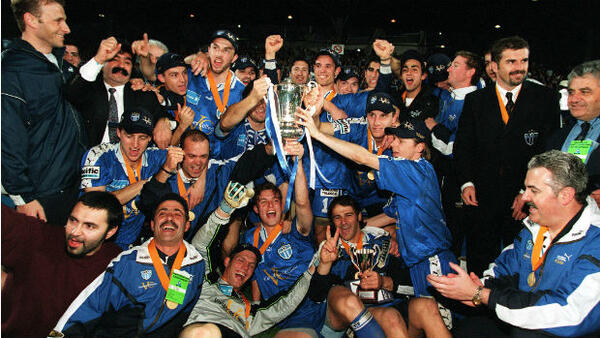
By this time, only South Melbourne and Melbourne Knights remained in the NSL, but the winds of change would soon dawn in 2004, with the Crawford Report delivering a final hammer blow to a competition which debuted in 1977 and would run for twenty-eight seasons, showcasing the best players from Victoria and Australia, and providing seven championships to Victorian clubs.
